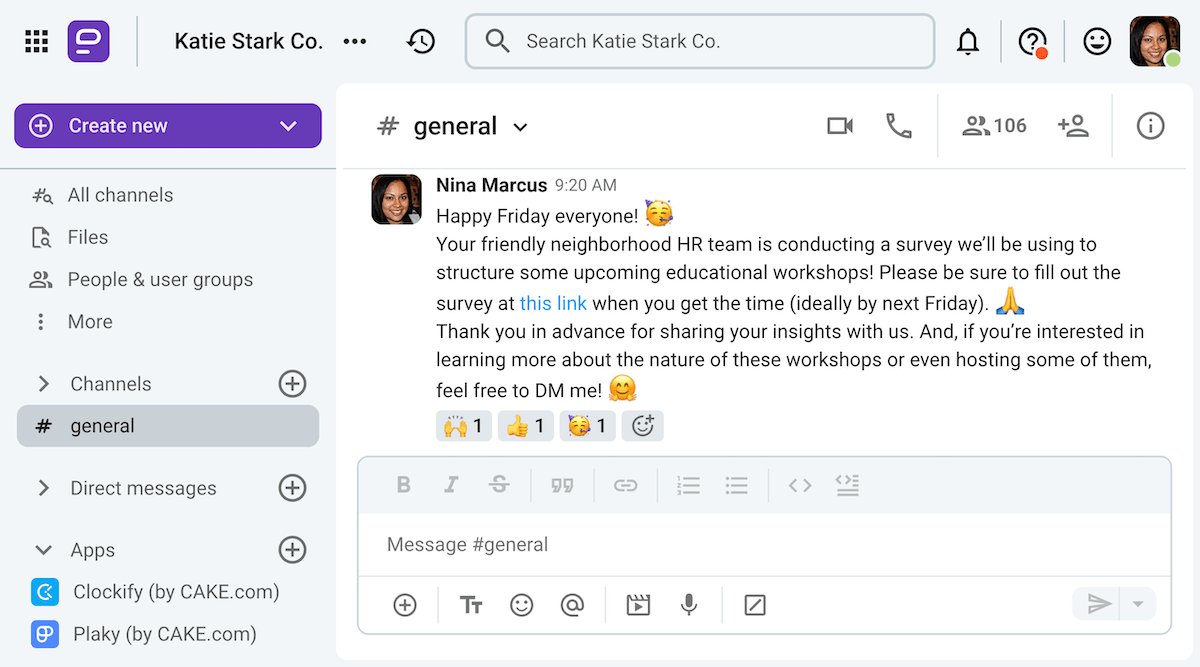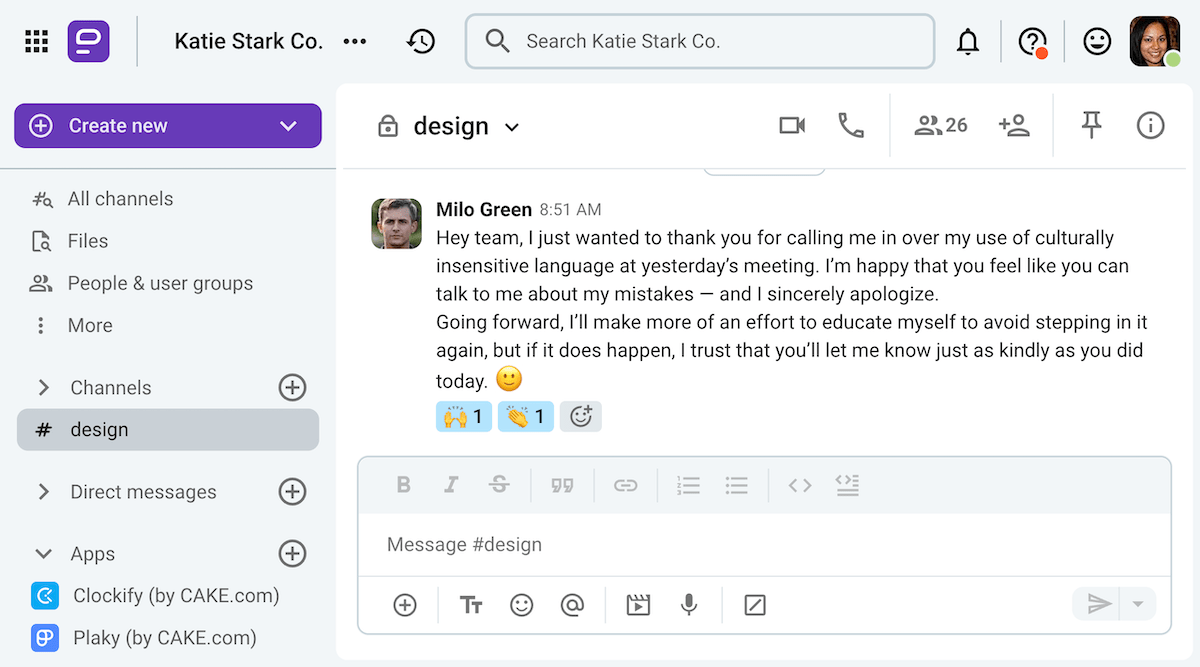Did you know that companies that have a more diverse workforce tend to financially outperform those who don’t by up to 39%?
In fact, that number has been steadily increasing since 2015, when McKinsey & Company’s diversity report showed a number closer to 15%.
At their best, multicultural teams can produce better results than culturally homogenous ones, as their brainstorming and problem-solving processes tend to involve people with different perspectives. In short, more diverse teams are able to analyze problems from different angles and present unique solutions incorporating the different experiences of their members.
However, that’s only if all those perspectives are equally valued and taken into account when decisions are being made.
If they’re not, the resulting erosion of workplace trust and productivity can decrease employee morale and increase turnover.
So, what can you do to prevent that?
Well, you could start by exploring two important frameworks for understanding the process of cross-cultural communication in the workplace.

- Edward T. Hall’s concept of high-context and low-context cultures is one of the key frameworks for understanding the nuances of cross-cultural communication.
- Geert Hofstede’s cultural dimensions like power distance, uncertainty avoidance, and individualism vs collectivism can shed more light on cultural differences that may affect communication at work.
- Cross-cultural communication in the workplace can be obstructed due to physical distance, ethnocentrism, language barriers, as well as differences in the use of nonverbal cues, perceptions of time, feedback styles, and hierarchical values.
- The best ways to improve cross-cultural communication in the workplace include establishing communication standards, educating your employees, and encouraging curiosity and genuine connection.
Table of Contents
Key frameworks for understanding cross-cultural communication in the workplace
If you want to know how to improve cross-cultural communication in the workplace, you should start by having a basic understanding of two key frameworks:
- Edward T. Hall’s high- and low-context cultures, and
- Geert Hofstede’s cultural dimensions.
These two social scientists have come up with various dichotomies we can use to analyze different cultures’ approaches to communication and gain a greater understanding of the clashes that can occur as a result of ethnocentrism at work.
So, without further ado, let’s start with dissecting Hall’s concept of high-context vs low-context cultures.
Edward T. Hall’s high-context vs low-context cultures
Edward T. Hall was an American anthropologist known for developing the concept of proxemics — which we’ve previously discussed in our article on the 4 types of communication (and will revisit in this article as well).
However, he also spent a significant portion of his career researching cross-cultural communication, which resulted in the high-context and low-context communication framework. In Beyond Culture, one of his earlier works on the topic, Hall presented the following definition of these terms:
“A high-context (HC) communication or message is one in which most of the information is already in the person, while very little is in the coded, explicit, transmitted part of the message.
A low-context (LC) communication is just the opposite; i.e., the mass of the information is vested in the explicit code.
Twins who have grown up together can and do communicate more economically (HC) than two lawyers in a courtroom during a trial (LC), a mathematician programming a computer, two politicians drafting legislation, two administrators writing a regulation.”
In other words, in high-context cultures, speakers may assume that the listeners already have access to certain information and, therefore, may not explicitly state everything when describing events.
On the other hand, people in low-context cultures tend to assume that listeners have no prior knowledge (or memory) of the event being discussed and expect to be spoken to in a similar manner.
Share just the right amount of information with Pumble
Professional communication in high-context vs low-context cultures
Based on the examples listed in Hall’s definition, we might say that professional communication is naturally on the low-context end of the spectrum. However, it may not be classified that way across cultures.
As a result, coworkers from different cultures may experience misunderstandings in the workplace, as:
- High-context people might become irritated when low-context people provide information they don’t need, and
- Low-context people can feel lost when high-context people don’t provide enough information.
So, it’s important to understand where we and our coworkers exist on this spectrum and act accordingly.
| LOW-CONTEXT CULTURES | HIGH-CONTEXT CULTURES |
|---|---|
| — Rely on clear and extensive (verbal or written) communication — Daily interactions require in-depth background information — Compartmentalized information networks (friends, family, coworkers), limited in scope and development — Separate offices at work, coworkers must schedule meetings to touch base — Examples include the US, the UK, Germany, Switzerland, and Scandinavian countries | — Rely on a preexisting knowledge of the context and nonverbal cues — Don’t require in-depth background information in daily interactions — Maintain extensive information networks via close personal relationships — Shared offices with people freely coming and going, seeking and giving information — Examples include Japan, China, Arabic and Mediterranean countries |
Keep in touch with remote team members on Pumble
Hofstede’s cultural dimensions
While Hall was shaping his theory of high-context vs low-context cultures, psychologist Geert Hofstede was developing his concept of cultural dimensions.
In the latter half of the 20th century, Hofstede got a chance to work at IBM, tasked with collecting and analyzing survey data from over 100,000 IBM employees working in over 50 countries.
This work resulted in the creation of Hofstede’s 4 cultural dimensions, which he later expanded upon. By the time Hofstede published his 2011 paper, Dimensionalizing Cultures: The Hofstede Model in Context, the framework compared cultures based on:
- Small vs large power distance, i.e. the extent to which the less powerful members of organizations accept and expect that power is distributed unequally (lesser in Germany and Western, English-speaking countries; greater in Eastern Europe, Asian, and African countries, according to Hofstede),
- Weak vs strong uncertainty avoidance, i.e. the level of anxiety employees experience in the face of ambiguity (lower in China, as well as Nordic and English-speaking countries; higher in East and Central Europe, Latin America, Japan, and Germany),
- Individualism vs collectivism, i.e. the degree of integration into and identification with social groups (individualist West vs collectivist East, generally, with Japan taking a middle position — according to Hofstede),
- Masculinity vs femininity, i.e., the degree of emotional and social role differentiation between the genders (masculine societies like Japan, German-speaking countries, Italy, and Mexico have a greater degree of role differentiation, as opposed to France, Chile, Korea, and the Nordic countries),
- Short-term vs long-term orientation, i.e., the belief that the most important life events take place in the past or present vs the future (the US, Australia, Latin American, and African countries are short-term oriented, while East Asian Countries, Eastern and Central Europe are long-term oriented), and
- Indulgence vs restraint, i.e., whether a society indulges or controls basic desires related to enjoying life and having fun (South and North America, Western Europe, and parts of sub-saharan Africa are more indulgent than Eastern European, Asian, and Muslim cultures).
In reality, of course, these divisions may not be so clear-cut. Besides, this is just a brief overview of Hofstede’s cultural dimensions that doesn’t go into all the details of the theory.
7 Common barriers to effective cross-cultural communication (and how to overcome them)
If you’re trying to determine how to improve cross-cultural communication in the workplace, you should also know some of the most common obstacles you may encounter in the process.
Going forward, we’re going to take a look at the 7 most common communication barriers that might hinder cross-cultural understanding:
- Physical distance,
- Ethnocentrism,
- Language & idioms,
- Nonverbal cues,
- Perceptions of time,
- Feedback styles, and
- Hierarchical values.
So, let’s see some examples of cross-cultural miscommunication that might occur as a result of these barriers.
Barrier #1: Physical distance
Physical distance isn’t a requirement for cross-cultural communication. After all, people from different cultures can share an office building. However, in remote-first companies, distance and time zone differences often introduce some challenges to communication.
But, though not sharing the same space can make effective communication somewhat difficult, it’s certainly not impossible.
Team communication apps like Pumble can let your team collaborate and communicate asynchronously by:
- Keeping communication organized with channels and threads, thereby ensuring that everyone has all the information they need to do their jobs,
- Scheduling messages so as not to disturb coworkers in different time zones, and
- Adjusting your notification preferences to make sure you’re not disturbed when you’re off the clock.

Generally speaking, any issues that may come up because of time zones and physical distance can be solved by adopting a more flexible and understanding approach to communication.
Communicate anywhere, anytime — with Pumble
Barrier #2: Ethnocentrism
The human tendency to subconsciously evaluate all other cultures through the lens of our own is a barrier to cross-cultural communication that most others stem from.
Negative preconceptions of other cultures like prejudice, bias, and stereotypes are often the result of ethnocentrism. However, positive evaluations of other cultures can also be the result of assumptions of similarity, which can be made through an ethnocentric lens.
Examples of cross-cultural miscommunication caused by ethnocentrism might include:
- Believing that your overseas coworkers’ way of executing tasks is wrong because you were taught to do them differently,
- Misinterpreting the intentions behind other people’s verbal and nonverbal behaviors without understanding their cultural significance, as well as
- Engaging in in-group favoritism by only highlighting the contributions of coworkers who share your cultural background.
Unfortunately, even social scientists haven’t managed to completely root out this particular way of thinking. But, even though there’s no way to eliminate this obstacle to cross-cultural communication in the workplace, we can still mitigate it by educating ourselves and clearly communicating that ethnocentrism has no place in our team values.
Establish your team values on Pumble
Barrier #3: Language & idioms
The next potential barrier to practicing effective cross-cultural communication in the workplace comes in the form of a practical concern. Even if everyone speaks the same language, misunderstandings between native and non-native speakers can still occur.
People who don’t speak in their native tongue at work may not understand all the phrases their coworkers use. And worse, they may feel too embarrassed to double check whether they’ve understood their coworkers.

On the other hand, native speakers who work with non-native speakers may foster some linguistic prejudice, which can manifest as a bias against people who don’t meet their standards for language fluency.
Even between people who share the same mother tongue, there may still be some prejudice toward those who speak in certain accents or dialects.
In these kinds of situations, it can be tempting to overcorrect and never mention these differences for fear of offending your coworkers. But, according to the author, communication expert, and public speaking instructor at the University of Toronto’s School of Continuing Studies, Ivan Wanis Ruiz, that’s not the right call either:

“One of the biggest barriers is our reluctance to name the elephant in the room. If someone has a strong accent, coworkers might pretend to understand rather than ask for clarification, worried they might offend. The solution is to normalize openness early on.”
So, when in doubt, just keep it simple by speaking slowly and taking turns to speak so everyone has a chance to contribute to the conversation.
Barrier #7: Hierarchical values
Last but not least, the fact that different cultures have different approaches to hierarchy should come as no surprise.
Even Hofstede’s cultural dimensions took note of cultures that have a smaller vs larger power distance — with the greater distance being more prominent in Asian, Eastern European, and African countries.
Naturally, having different understandings of the importance of hierarchy can lead to all sorts of cross-cultural conflicts in the workplace, as HR expert and the CEO of a global HR and Employer of Record platform, Lucas Botzen, told us:

“Incorrect assumptions about hierarchy or decision-making styles, especially in high-context and low-context cultures, can also lead to confusion. Indirect communication in some cultures, for example, is a sign of respect, but for others, it may be evasive or ambiguous.”

💡 PUMBLE PRO TIP
The image above shows an employee getting in touch with his work buddy’s manager — an example of diagonal communication in the workplace. To learn more about this type of communication, check out this guide:
How to improve cross-cultural communication in the workplace: 7 actionable strategies
Now that we know some of the cross-cultural communication barriers you may face as you attempt to make your workplace a multicultural wonderland, let’s talk about some specific steps you can take to achieve that goal.
Going forward, we’ll discuss how you can:
- Set the right tone,
- Educate your team (and yourself),
- Establish communication standards,
- Encourage active listening,
- Foster a curious, rather than judgmental, environment,
- Ensure understanding by avoiding slang, jargon, and certain types of humor, and
- Strengthen camaraderie with team-building activities.
So, let’s jump right in.
Strategy #1: Set the right tone
If you want to know how to improve cross-cultural communication in the workplace, you should start by setting the right tone yourself.
According to Ivan Wanis Ruiz, one way to do that would be to make sure everyone knows that they can ask you to explain yourself any time they don’t understand something you’ve said or done:

“You can set the tone by letting others know it is okay to ask questions about your tone or nonverbal communication. Doing this gives people permission to speak honestly and reduces friction within the team.”
Having an open-door policy in general is a useful way to establish psychological safety in the workplace — especially if you’re a part of the cultural majority at your organization.
However, since there’s a chance that no one will want to be the first to ask if they don’t understand something, you might want to ask a trusted coworker to break the ice. Once they do, your calm response and explanation will signal to the others that asking clarifying questions is not only allowed — but encouraged.

Record your meetings in Pumble
Strategy #2: Educate your team
Another way to make everyone realize that mastering cross-cultural communication is a necessity in your organization would be to simply provide ongoing cultural sensitivity training.
The goal of these workshops should be to increase your team members’ self-awareness and point out some of the subconscious biases they might have.
If you work for a multinational corporation that’s struggling to bridge the gaps between employees in different countries, make your educational workshops reflect that reality by:
- Asking your employees what kinds of microaggressions they might be facing in the workplace and what they wish employees from other countries knew about their culture,
- Taking note of the gaps in knowledge your cultural majority employees might have, and
- Creating an educational program with these specific problems in mind.

Host your educational workshops on Pumble
Hopefully, doing so should get some of your employees to let go of their ethnocentrism and approach their foreign coworkers with empathy.
After all, as Lisa M. Sanchez, the Vice President of Employee Experience and Engagement at ArtCenter College of Design, put it — these are the basic rules of communication we should follow regardless of the cultural composition of our workplace:

“Communication fundamentals still matter in cross-cultural environments. It’s about treating people with dignity and respect and valuing our differences.”
Strategy #3: Establish communication standards
Whether you work for a multicultural organization or not, having clearly outlined communication protocols is going to be an important part of your organizational culture overall, as Lisa M. Sanchez noted:

“Cross-cultural communication is part of the overall culture of the organization. Organizational culture defines customs, language, beliefs, and norms that are either accepted, tolerated, or granted permission where there’s no intervention to stop inappropriate communication.”
In other words, cross-cultural communication in the workplace is much easier if your employees have certain policies and protocols to fall back on, such as:
- Protection against microaggressions and other forms of bias and prejudice at work,
- Procedures for conflict resolution between employees (as well as disciplinary measures for repeat offenders),
- Organizational documentation that takes into account linguistic and cultural differences between employees and uses culturally-sensitive language, and even
- Policies on work hours (for example, if a part of your workforce is in another time zone, it can be helpful if their work hours somewhat overlap with the majority of your employees, as shown in the image below).

Obviously, your processes should allow for some degree of flexibility. Ideally, you wouldn’t write an employee up over a minor case of accidental cultural insensitivity.
However, you can create policies that recognize and respect the cultural differences of your employees, as an HR Manager at a global workforce management company, Sheriah Boehm, noted:

“Inclusivity extends beyond just communication styles. It can influence policies, training approaches, leadership modeling, and even seemingly small details such as email etiquette. The goal is to adapt, not homogenize, ensuring every team member feels included and understood.”
Strategy #4: Encourage active listening
While you develop your cultural sensitivity training modules, you might want to focus a workshop or two on the skill of active listening.
As Lucas Botzen told us, cross-cultural communication requires intentionality and practice. Developing good listening skills is the best way to introduce both of those requirements into any conversation:

“My standard advice is to listen carefully and pose clarifying questions rather than assuming meaning — a mark of respect and a means of avoiding misunderstanding. Investing time in understanding the cultural background and communication norms of colleagues can reap enormous benefits in terms of trust and productivity.”
However, when it comes to asking clarifying questions, we should keep in mind that people from different cultural backgrounds may respond differently to certain types of questions.
For example, active listening often requires some degree of reflection — you might paraphrase a statement to make sure you’ve understood the gist of what the other person was saying, as shown in the example below.

But, if the other person is from a cultural background that values hierarchy and you’re technically above them on the company ladder, they may feel compelled to answer any “yes or no” questions you pose with a positive to avoid offending you.
Similarly, some people (typically those from a high-context cultural background) might find certain behaviors we tend to use as indicators of active listening overwhelming or even aggressive. Things like prolonged eye contact or direct questions may be unnerving to someone who comes from a culture that values subtlety and indirection over bluntness.
Ask the right questions on Pumble
Strategy #5: Foster a curious, rather than judgmental, environment
With any luck, the efforts you’ve made to improve cross-cultural communication in the workplace until this point will have resulted in a more open-minded workforce overall.
But, if they haven’t, here are some more things you can do to encourage your employees to be more curious about other cultures:
- Recognize the religious and national holidays of employees from different cultural backgrounds,
- Be open to all ideas (and be able to explain why you chose one over the other), and
- Normalize admitting to, apologizing for, and learning from mistakes.

After all, as Ivan Wanis Ruiz told us, correctness shouldn’t be the goal of cross-cultural communication:

“Ultimately, cross-cultural communication improves when both sides make curiosity — not correctness — the goal.”
To that end, companies should encourage their diverse local teams to participate in crafting their DEI strategy by introducing their own DEI initiatives — which was one of the 5 recommendations shared in McKinsey & Company’s latest diversity report we previously mentioned.
By prioritizing belonging and inclusive practices, organizations can create an environment that fosters curiosity even in employees who belong to the cultural majority.
Strategy #6: Ensure understanding by avoiding slang and jargon
If your employees aren’t native or, at least, fluent speakers of the same language, it could be helpful to avoid slang and jargon to ensure understanding.
Instead, you should stick to simple vocabulary, as the CFO of a global workforce management company, Sierra Hinson, advises:

“It is also important to choose more universal words and phrases to make sure that everyone can understand your message. Many people in business utilize Globish.”
For Sierra, word choice tends to be one of the biggest challenges to cross-cultural communication in the workplace:

“Sometimes, that means using a word that has more than one meaning in English (like later) or using overly complex verbiage. Being a Midwesterner, I find myself often using idioms that fall short of understanding on the other side.”

Humor can be a similarly touchy subject when not everyone has the same level of linguistic understanding.
After all, jokes often rely on turns of phrase and much of Western humor is also based on sarcasm, which can have adverse effects when used in a professional setting. And, things can get even dicier when people start making jokes based on cultural stereotypes or at the expense of certain minority groups.
As Lisa M. Sanchez put it, when in doubt, look at who your audience is:

“What’s funny to one may not be funny to the next person, especially if the jokes are off-colored and related to culture or stereotypes. You must know your audience.”
So, the next time you want to crack a joke at work, take a moment to consider whether anyone might get offended by it.
Strategy #7: Strengthen camaraderie with team-building activities
Ultimately, no amount of cultural sensitivity training will be able to replace genuine human connection.
But, at the end of the day, culture is just one aspect of a person. As Ivan Wanis Ruiz noted, personality often matters more:

“Every culture has introverts and extroverts, empathetic and non-empathetic people. These personal traits shape how we interact far more than broad cultural stereotypes. Culture provides a framework, but personality drives how communication actually plays out.”
With that in mind, the best way to encourage your employees to get on the same page would be to facilitate meaningful conversations between them.
And, though not an ideal solution, team-building activities could help you break the ice and nudge your team in the right direction.
Even starting meetings by asking what everyone had for lunch could spark a conversation and get everyone more curious about each other — which is the goal, after all.

How the right tools can help you foster a culturally intelligent digital workplace
If you’re looking to improve cross-cultural communication in the workplace, you’ll have to take a systemic approach to raising cultural intelligence and awareness.
HR managers and leadership can do this by continuously emphasizing psychological safety at work so everyone feels respected and valued, as Sheriah Boehm told us:

“As an HR Manager, it is vital to:
- Listen actively,
- Approach differences respectfully, and
- Create a safe, inclusive space where all employees feel valued.
Cultural intelligence, which is the ability to adapt communication and behaviors to diverse cultural contexts — must continuously evolve as we evolve as an organization. Differences should be celebrated as strengths, and we should seek to build bridges rather than require everyone to adopt a single communication style.”
Of course, if you work in a multicultural organization, chances are that not all your employees share the same physical location, which can make it somewhat difficult to foster that sense of unity.
However, tools like Pumble by CAKE.com, a team communication app, can make it easy to set up a flexible communication hub that suits all employees, no matter what cultural background they come from.
Pumble can provide the clarity required for low-context communication by letting you:
- Organize communication into direct messages, group chats, channels, and threads, and
- Create an easily searchable database of messages and documents.
On the other hand, the platform can also be used to enrich high-context communication through:
- Video and voice messages, which deliver more nonverbal cues than text messages ever could (even though Pumble users can also use GIFs and emojis to communicate), and
- Video conferencing features, which allow users to have more genuine conversations but also keep meetings productive (with features like screen sharing, hand raising, and emoji reactions) and on the record.
In other words, Pumble has features that can support all kinds of diverse communication styles.
Overcome cross-cultural communication barriers with ease.








